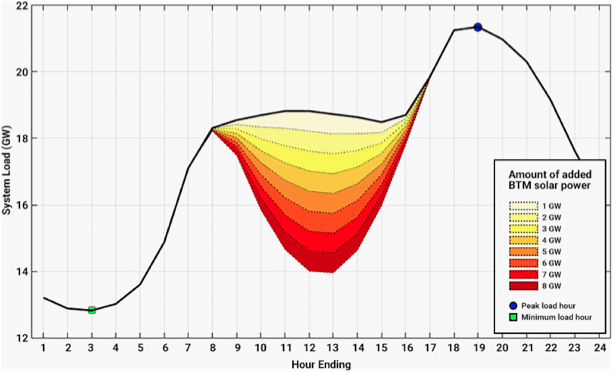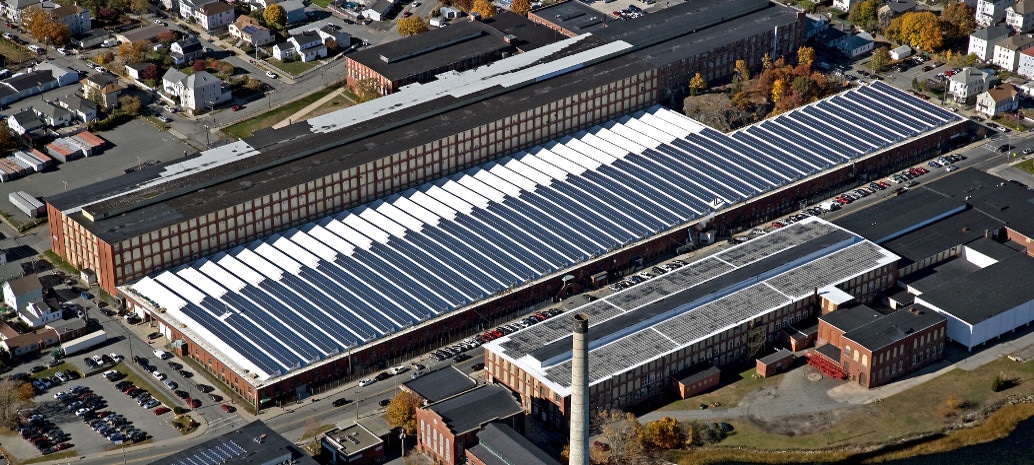Solar is upending the way that we approach power markets. As one example, for the last century of so, the construction of new power plants in the United States has been driven by rising peak demand peaks, because what is typically needed at the system level is to meet the level of demand seen on a hot summer day when air conditioners and fans are all on.
And while this still set the level of overall capacity needed, something new is happening. In places with high penetrations of behind-the-meter solar, peak summer demand on the bulk power system is going down, not up.
One of the places where this is most visible may surprise you. The windy shores of Cape Cod are not the first place most people think of when they think of solar, but the nearly 3 GWac that has been installed in the six-state region has already reversed the upward trend of the summer peak.
The latest 10-year forecast issued by the New England Independent Operator (ISO-NE) shows that while gross demand is still rising, solar and energy efficiency are driving these peaks down. The organization estimates that New England’s installed solar capacity is going to more than double over the next decade to 6.7 GWac, and that this is going to drive down the summer peak by around 600-900 MW.
The uncertainty in these numbers comes from the fact that no one, including the grid operator, knows exactly how high electric demand will rise in any given summer. But even in its “90/10” load projection, ISO-NE shows summer peak load falling from from 27.2 GW to 26.6 GW from 2019 to 2028.
Incidentally, ISO-NE also sees overall power demand falling due to solar and efficiency. But while this 4% fall may be larger in percentage terms, it may not be as consequential. As explained in the report:
Net peak demand, thus, is not a key driver of new infrastructure needs over the 10-year planning horizon. Growth of demand over the longer term seems likely, however, with additional electrification of transportation and the use of efficient heat pumps replacing fossil systems for providing heating and cooling.
If this were Texas or California, I would say that this is great news for power prices, but in New England these spike in the winter, not the summer. What this does mean is that under the current scenario, the region doesn’t need as many new conventional power plants to keep its reverse margin intact, even with retirements of existing units.
Need for new services
But that doesn’t mean that there aren’t needs. Specifically, ISO-NE says that both behind-the-meter and large-scale solar are creating needs for regulation, ramping, reserves, and voltage control. It states these can be met by flexible resources, storage, demand response, Flexible Alternating Current Transmission Systems (FACTS), and “other controls on variable energy resources”.
One of the big problems that ISO-NE and other grid operators have is that they have limited visibility into rooftop and other forms of behind the meter solar, and no control over its output. The organization has expressed that it will need to be able to “observe and control variable and distributed resources” in order to fully realize the benefits of energy storage, microgrids and smart grid technologies.
Some of the technical tweaks to make behind-the-meter solar be a good player on the grid are already happening. ISO-NE notes that the implementation of voltage and frequency ride-through requirements in IEEE 1547 will improve overall system reliability. But it argues that more work is still needed:
The full implementation of recently approved interconnection standards and testing requirements for distributed resources will prove vital for ensuring overall system reliability and facilitating the economical development of renewable resources, such as PV.
Another concern that ISO-NE has expressed is that even though the higher summer peak is being progressively driven down, this moves the net peak to later in the day, and during the winter the daily peak isn’t served by solar at all. In fact, ISO-NE reported its first system-wide “duck curve” 18 months ago, when solar drove net daytime demand below the overnight demand level. But this was an unusual day, and most of the time in fall, winter and spring more solar just means a steeper evening ramp.

Graphic: ISO New England
Massachusetts appears to already be ahead of this game, as it is currently designing a Clean Peak Standard to meet peak demand in all four seasons. The latest design of the CPS and its four hour windows appears to be custom-made for the participation of battery storage.
Also, there is a need to point out that unlike many regions which are dependent on relatively inflexible coal and nuclear power plants, New England’s grid is dominated by gas plants, which tend to be more flexible. And with several massive offshore wind plants scheduled to come online over the next four years, even the limitations of existing gas pipelines may not end up being the dire threat to reliability that those who are invested in building these pipelines would like you to believe.
This content is protected by copyright and may not be reused. If you want to cooperate with us and would like to reuse some of our content, please contact: editors@pv-magazine.com.









By submitting this form you agree to pv magazine using your data for the purposes of publishing your comment.
Your personal data will only be disclosed or otherwise transmitted to third parties for the purposes of spam filtering or if this is necessary for technical maintenance of the website. Any other transfer to third parties will not take place unless this is justified on the basis of applicable data protection regulations or if pv magazine is legally obliged to do so.
You may revoke this consent at any time with effect for the future, in which case your personal data will be deleted immediately. Otherwise, your data will be deleted if pv magazine has processed your request or the purpose of data storage is fulfilled.
Further information on data privacy can be found in our Data Protection Policy.